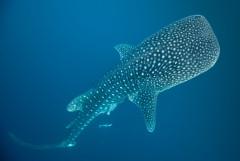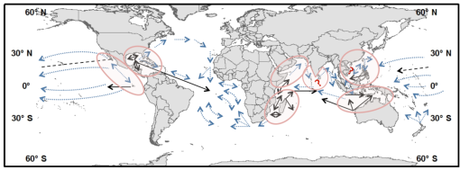
© W Osborn (AIMS)
Well, since my own institute beat me to the punch on announcing our latest whale shark paper (really, far too keen, ladies & gents), I thought I’d better follow up with a post of my own.
We’ve mentioned our previous whale shark research before (see here and here for previous posts, and see the end of this post for a full list of our whale shark publications), but this is a lovely extension of that work by my recently completed PhD student, Ana Sequeira.
Her latest contribution, Inferred global connectivity of whale shark Rhincodon typus populations just published online in Journal of Fish Biology, describes what a lot of whale shark punters & researchers alike have suspected for a long time – global connectivity of all the oceans’ whale shark populations. The problem hasn’t been a lack of ‘evidence’ for this per se; there is now sufficient evidence from genetic studies that at least on the generational scale (a single generation could be up to 37 years long), populations among the major ocean basins are connected via migration (Castro et al. 2007; Schmidt et al. 2009). The problem instead is that no one has ever observed a shark voyage between ocean basins, nor has anyone really suggested how and over what time scales this (must) happen.
Until now, that is.
The paper outlines a novel ‘global connectivity’ model that explains, based on existing tracking, observational and genetic data, the most likely migration pathways of whale sharks within and between major oceans. In other words, it’s the first time that someone has formalised what we’ve all been thinking about for decades (yes, I am proud of Ana).

Whale shark migration patterns depicting possible whale shark populations (red circles) considering that even though they are highly migratory animals at some part of their life-cycle they just perform shorter migrations within geographically close locations. A possible time link between those “aggregation” sites and distant locations that would allow the inter-ocean populations to mix is shown by doted arrows inblue. Black arrows denote movements revealed by tagging studies and dashed lines indicate no current evidence for a possible migratory path (except the existence of tracked shark that performed a 13,000 km migration on a east to west intra Pacific ocean migration – Eckert and Stewart, 2001, shown by the back dotted line). Question marks in red indicate areas where further studies are needed.
I’m not going to go in great detail here (that’s what the paper does) as you can easily download or request a copy from me. But I will highlight one other thing we mention that has bothered me and many others for years. Some of the original satellite tracking work by Eckert & Stewart suggested an amazing trans-Pacific journey of one tagged female shark based on a some rather questionable data. The track in question can be viewed in our paper (or the original) – it is clearly an artefact of a detached tracker that floated passively on ocean currents and is unlikely to reflect any real whale shark migration patterns. We finally had to say something about it.
CJA Bradshaw
–
References
- Sequeira, A, C Mellin, S Delean, MG Meekan, CJA Bradshaw. 2013. Spatial and temporal predictions of inter-decadal trends in Indian Ocean whale sharks. Marine Ecology Progress Series doi:10.3354/meps10166
- Sequeira, A, C Mellin, MG Meekan, DW Sims, CJA Bradshaw. 2013. Inferred global connectivity of whale shark Rhincodon typus populations. Journal of Fish Biology doi:10.1111/jfb.12017
- Speed, CW, MG Meekan, IC Field, CR McMahon, CJA Bradshaw. 2012. Heat-seeking sharks: support for behavioural thermoregulation in reef sharks. Marine Ecology Progress Series 463: 231-245 doi:10.3354/meps09864
- Sequeira, A, C Mellin, D Rowat, MG Meekan, CJA Bradshaw. 2012. Ocean-scale prediction of whale shark distribution. Diversity and Distributions 18: 504-518. doi:10.1111/j.1472-4642.2011.00853.x
- Sleeman, JC, MG Meekan, SG Wilson, JJ Polovina, JD Stevens, GS Boggs, CJA Bradshaw. 2010. To go or not to go with the flow: environmental influences on whale shark movement patterns. Journal of Experimental Marine Biology and Ecology 390: 84-98. doi:10.1016/j.jembe.2010.05.009
- Sleeman, JC, MG Meekan, BM Fitzpatrick, CC Steinberg, R Ancel, CJA Bradshaw. 2010. Oceanographic and atmospheric processes influence the abundance of whale sharks at Ningaloo Reef, Western Australia. Journal of Experimental Marine Biology and Ecology 382:77-81. doi:10.1016/j.jembe.2009.10.015
- Rowat, D, CW Speed, MG Meekan, M Gore, CJA Bradshaw. 2009. Population abundance and apparent survival of the Vulnerable whale shark in the Seychelles aggregation. Oryx 43: 591-598. doi:10.1017/S0030605309990408
- Rowat, D, M Gore, MG Meekan, IR Lawler, CJA Bradshaw. 2009. Aerial survey as a tool to estimate whale shark abundance trends. Journal of Experimental Marine Biology and Ecology 368: 1-8. doi:10.1016/j.jembe.2008.09.001
- Bradshaw, CJA, BM Fitzpatrick, CC Steinberg, BW Brook, MG Meekan. 2008. Decline in whale shark size and abundance at Ningaloo Reef over the past decade: the world’s largest fish is getting smaller. Biological Conservation 141: 1894-1905. doi:10.1016/j.biocon.2008.05.007
- Speed, CW, MG Meekan, D Rowat, S Pierce, AD Marshall, CJA Bradshaw. 2008. Scarring patterns and relative mortality rates of Indian Ocean whale sharks. Journal of Fish Biology 72: 1488-1503. doi:10.1111/j.1095-8649.2008.01810.x
- Speed, CW, MG Meekan, B Russell, CJA Bradshaw. 2008. Recent whale shark (Rhincodon typus) beach strandings in Australia. Marine Biodiversity Records 2: e15. doi:10.1017/S1755267208000158
- Bradshaw, CJA. 2007. Swimming in the deep end of the gene pool – global population structure of an oceanic giant. Molecular Ecology 16: 5111-5113. doi:10.1111/j.1365-294X.2007.03548.x
- Speed, CW, MG Meekan, CJA Bradshaw. 2007. Spot the match – wildlife photo-identification using information theory. Frontiers in Zoology 4:2. doi:10.1186/1742-9994-4-2
- Bradshaw, CJA, HF Mollet, MG Meekan. 2007. Inferring population trends for the world’s largest fish from mark-recapture estimates of survival. Journal of Animal Ecology 76: 480-489. doi:10.1111/j.1365-2656.2006.01201.x
- Sleeman, JC, MG Meekan, SG Wilson, CKS Jenner, MN Jenner, GS Boggs, CJA Bradshaw. 2007. Biophysical correlates of marine megafauna distributions at Ningaloo Reef, Western Australia. Marine and Freshwater Research 58: 608-623. doi:10.1071/MF06213
- Meekan, MG, CJA Bradshaw, M Press, C McLean, A Richards, S Quasnichka, JG Taylor. 2006. Population size and structure of whale sharks (Rhincodon typus) at Ningaloo Reef, Western Australia. Marine Ecology Progress Series 319: 275-285. doi:10.3354/meps319275

